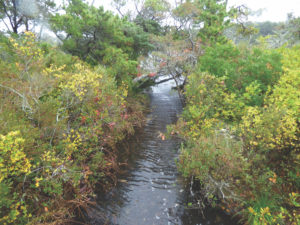
EASTHAM — The culvert connecting Great Pond and Deborah’s Pond will be replaced to allow significantly increased water flow, the conservation commission decided last week. This is good news for herring, which return each spring to Eastham’s brooks and ponds to spawn.
The commission voted 5-0 on Oct. 9 to increase the size of the culvert under Great Pond Road from 10 inches in diameter to 35 inches. The town’s natural resources department presented the project plan in partnership with the Woods Hole Group, a consulting company based in Bourne, and Ryder & Wilcox, a surveying and engineering company in Orleans.
Herring Brook between Bridge Pond Drive and Cole Road sees an important herring run each year. The fish make their way from Cape Cod Bay underneath Herring Brook Road in a fish passage to Bridge Pond, and then on to Great Pond. Finally they migrate to Deborah’s Pond to reproduce, using the culvert just north of the public beach at Great Pond.
But the old culvert has deteriorated, said Adam Finkle of the Woods Hole Group in presenting the project to the commission. He said the culvert was receiving direct storm water runoff from Great Pond Road and Colony Road.
“That storm water discharge has led to the slumping of Great Pond Road itself,” said Finkle, “and it appears as though continued failure of the roadway surface is possible.”
“This is a project we’ve been working on for a few years,” said Eastham Conservation Agent Shana Brogan. It’s being funded through the Natural Resources Conservation Service and its water resources restoration grant program, she said.
Water levels in the ponds would remain unchanged, Finkle said. “Even though we would be increasing the size of the drain, we would be able to regulate the water level in Deborah’s Pond,” he said.
Finkle added that improvements would redirect storm water away from the existing discharge point, which is now directly into the stream channel. This will require some regrading of Great Pond Road, installation of a berm along the edge of the roadway to keep storm water moving past the existing discharge point, and a berm along Colony Road to help catch the storm water there.
The project will include removing invasive species in the area, restoring the site, and replanting the area. There will be no spraying of herbicides on invasive species, planners said. Instead, a drip bottle will be used.
The select board recently adopted a policy prohibiting the use of glyphosate on town-owned property, so Finkle said he will have to look into using an organic tryclopyr-based herbicide instead.
The replacement project should take about a week and will be maintained by the town’s natural resources department, Brogan said.



